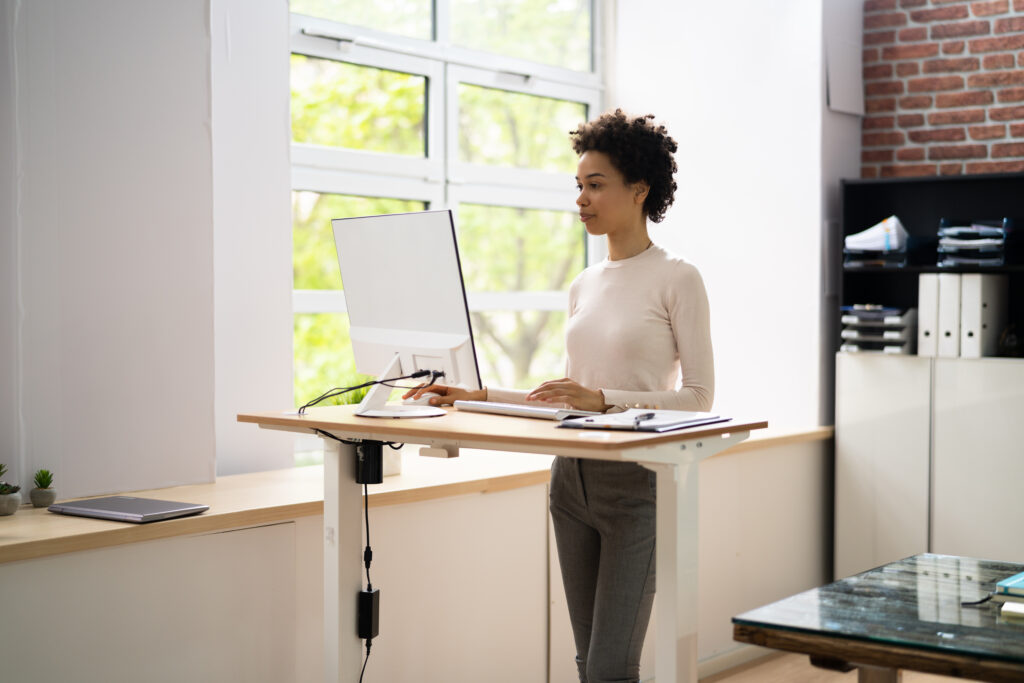As programmers, we’re used to hours in front of a screen, often caught in the same position, barely moving a muscle. It’s no surprise that back pain has become such a common issue in our field. Spending too much time in one place, hunched over, focused on code, can quickly add up to major discomfort—or worse, chronic pain.
Back pain isn’t just annoying; it’s a productivity killer. When your back hurts, every task seems a bit harder. Even getting through a day at work can feel like a marathon. But the good news is that we don’t have to accept this as part of the job. With the right exercises and a bit of mindfulness about our work setup, we can tackle back pain head-on.
In this guide, I’ll walk you through ten simple exercises that can make a huge difference. Plus, we’ll talk a bit about standing desks and how they can change things up for the better. So, whether you’re dealing with back pain right now or just want to prevent it, these tips can help you stay comfortable and focused.
Causes of Back Pain in Programmers

Back pain is so common among programmers that it almost feels like it comes with the job. But why exactly is that? There are a few major reasons that back pain tends to creep up on us:
- Sitting for Long Periods: The reality of programming often means hours on end at a desk. Our bodies aren’t built to stay still for that long, and prolonged sitting can lead to muscle stiffness, especially in the lower back. This lack of movement puts pressure on the spine, which over time can lead to pain and even injury.
- Poor Posture: It’s easy to start the day with good posture, but after a few hours of deep focus, most of us start to hunch or slouch. This posture can strain the muscles around the spine, causing them to work overtime to support the back. Over time, this bad habit can lead to chronic pain or issues like rounded shoulders and forward head posture.
- Inadequate Ergonomics: Our setup plays a big role. If a chair doesn’t support the lower back, or the monitor is too high or too low, we naturally adjust in ways that can strain the spine. Ergonomics might seem like just a fancy term, but when your desk and chair aren’t adjusted to suit your body, it can quickly lead to discomfort.
- Lack of Movement: Programming requires mental focus, which can mean we’re glued to our screens without much thought about moving around. The longer we stay still, the more our muscles stiffen up, leading to restricted movement and increased tension in the back.
- Stress and Tension: Yes, stress can actually contribute to back pain! When we’re stressed, we tend to hold tension in our shoulders and upper back. Over time, this tension can become pain as our muscles remain tight and contracted.
The Case for Standing Desks

Standing desks are getting more popular among programmers, and for good reason. Switching to a standing desk setup lets you alternate between sitting and standing, which can help reduce the strain caused by being in one position for too long. Here’s why they’re worth considering:
- Promotes Movement: One of the biggest benefits of a standing desk is that it allows you to shift positions throughout the day. Standing naturally encourages movement—you’ll likely shift your weight, stretch, and maybe even take more breaks to move around.
- Reduces Pressure on the Lower Back: Alternating between sitting and standing helps take some pressure off the lower back muscles. Standing also encourages a more neutral spine alignment, which can relieve the tension that often builds up when we sit.
- Improves Posture: With the right setup, a standing desk can make it easier to maintain good posture. Monitors at eye level and a standing position encourage better alignment of the spine and reduce the temptation to hunch forward.
- Boosts Energy Levels: Many people find that they feel more alert and focused when they stand. Standing can promote better blood circulation, which can help prevent that sluggish feeling that sometimes comes after sitting too long.
While a standing desk isn’t a cure-all for back pain, it’s a great tool to add to your routine. When combined with stretches and mindful posture, it can make a noticeable difference in your comfort and productivity.
1. Cat-Cow Stretch
- Description: This is a gentle, flowing movement from yoga that alternates between arching your back (Cow Pose) and rounding it (Cat Pose) while on all fours. Start on your hands and knees, with hands directly under your shoulders and knees under your hips. As you inhale, drop your belly toward the floor, lifting your gaze and tailbone. As you exhale, tuck your chin to your chest, draw your belly in, and round your back toward the ceiling.
- Benefits: This movement increases flexibility and mobility in the entire spine, especially the lumbar (lower back) and thoracic (upper back) regions. The Cat-Cow Stretch also helps to release tension built up in the back, neck, and shoulders, improving circulation along the spine and warming up the muscles, which can reduce stiffness and prevent injury.
2. Child’s Pose
- Description: Child’s Pose is a restful yoga position that stretches the lower back and hips. Begin by kneeling on the floor, sitting back onto your heels with your knees slightly apart. Extend your arms forward, lowering your torso down between your thighs until your forehead touches the floor. Breathe deeply as you sink into the stretch, reaching your arms out while keeping your shoulders relaxed.
- Benefits: This stretch is incredibly calming and offers relief for tight lower back muscles and hips. It helps to open up the spine and lengthen it, reducing pressure on the lower vertebrae and giving your back a gentle stretch. Child’s Pose is especially useful for decompressing the spine and can help alleviate tension in the back, shoulders, and neck, offering a relaxing counterbalance to long periods of sitting.
3. Pelvic Tilts
- Description: Pelvic tilts are simple yet effective exercises that can be done lying on your back. Begin by lying flat on your back with your knees bent and feet flat on the floor. Tighten your abdominal muscles and press your lower back into the floor, tilting your pelvis upward. Hold this position for a few seconds, then release.
- Benefits: Pelvic tilts strengthen the core and lower back muscles, both of which play a crucial role in supporting proper posture and spine alignment. By engaging these muscles, pelvic tilts help stabilize the spine and pelvis, reducing the risk of lower back pain. This exercise also promotes better movement and flexibility in the lower back, which is essential for relieving stiffness caused by prolonged sitting.
4. Knee-to-Chest Stretch
- Description: This stretch is done while lying on your back, with one or both knees drawn up to the chest. Start by lying down with both legs extended. Slowly bring one knee up toward your chest, clasping your hands around your shin or knee. Hold the stretch, then switch to the other leg or bring both knees up together.
- Benefits: The Knee-to-Chest stretch targets the lower back muscles, gently lengthening them to release tension. It helps alleviate pressure in the lumbar region and stretches the glutes and hip flexors, which are often tight from sitting. This stretch can also improve flexibility in the lower back, promoting better spinal alignment and easing discomfort caused by prolonged inactivity.
5. Piriformis Stretch
- Description: The Piriformis stretch focuses on a small but significant muscle located in the buttocks, which can tighten and put pressure on the sciatic nerve. To do this stretch, sit on the floor with one leg extended and cross the opposite leg over it. Place the foot flat on the floor, and gently twist your torso toward the bent knee.
- Benefits: This stretch helps reduce pressure on the sciatic nerve, alleviating sciatica pain, a common issue for those who sit for long hours. Stretching the piriformis muscle also enhances hip flexibility, which can lead to better posture and less strain on the lower back. This is especially beneficial for anyone dealing with pain radiating from the lower back down through the leg.
6. Seated Forward Bend
- Description: In this stretch, you’ll sit with your legs extended in front of you, keeping your back straight. Slowly reach forward, aiming to hold your feet or shins, while keeping your spine as elongated as possible. You can bend your knees slightly if needed for a more comfortable stretch.
- Benefits: The Seated Forward Bend deeply stretches the lower back, hamstrings, and calves, which can relieve tension in the lower spine. This stretch helps lengthen the muscles along the back of the legs and the lower back, making it easier to maintain a neutral posture. It’s especially helpful for relieving tightness caused by prolonged sitting and can also promote relaxation.
7. Wall Sits
- Description: Wall sits are a simple but powerful way to build strength in your legs and back. Stand with your back against a wall, then slide down until your knees are at a 90-degree angle, as if sitting on an invisible chair. Hold this position for as long as you can, keeping your core engaged.
- Benefits: Wall sits strengthen the muscles of the legs, glutes, and lower back, which are all essential for supporting the spine. By building these muscles, wall sits help maintain a strong posture, reducing the strain on your lower back from sitting. This exercise is also great for developing endurance, which helps prevent lower back fatigue.
8. Plank
- Description: To perform a plank, position yourself face down with your weight on your forearms and toes, keeping your body in a straight line from head to heels. Hold this position without letting your hips sag or rise.
- Benefits: The plank is a core-strengthening powerhouse. By engaging your core, back, and shoulders, the plank helps stabilize your spine and improve overall balance. A strong core reduces the load on your lower back, making it easier to maintain good posture during long periods of sitting. Planks also activate muscles across the entire body, promoting stability and endurance.
9. Bridge Pose
- Description: Start by lying on your back with your knees bent and feet flat on the floor, close to your hips. Pressing into your feet, lift your hips toward the ceiling, squeezing your glutes and engaging your core. Hold the pose, then slowly lower back down.
- Benefits: Bridge Pose is excellent for strengthening the glutes, lower back, and hamstrings, which all contribute to a stable pelvis and strong core. Strengthening these muscles helps relieve lower back pain and prevents instability in the spine. This exercise also promotes hip mobility and supports better posture by reducing lower back strain.
10. Cobra Stretch
- Description: The Cobra stretch is performed by lying on your stomach with your palms flat on the ground under your shoulders. Press into your palms, lifting your chest and upper body off the ground while keeping your hips on the floor.
- Benefits: This stretch opens up the chest and lengthens the spine, increasing flexibility in the lower back and reducing tightness. The Cobra stretch helps counteract the effects of sitting by extending the spine and stretching the abdominal muscles. It’s a rejuvenating stretch that can relieve tension in the back and improve overall spinal mobility.
Ergonomic Tips for Programmers
Setting up a comfortable and ergonomic workspace can make a huge difference in preventing back pain. Here are some key tips to help you adjust your sitting posture, monitor, and chair to better support your back:
- Chair Setup: Choose a chair that supports your lower back. Look for adjustable lumbar support to maintain the natural curve of your spine. Keep your feet flat on the floor, with knees at a 90-degree angle. Avoid crossing your legs, as this can shift your posture and create strain.
- Monitor Position: Place your monitor directly in front of you, about an arm’s length away, with the top of the screen at or slightly below eye level. This prevents neck strain and encourages a neutral head position. If you’re using a laptop, consider using a stand or an external monitor to bring the screen to eye level.
- Desk Adjustments: An adjustable desk can be a game-changer. Switching between sitting and standing throughout the day allows you to move more, relieving pressure on the lower back. If a standing desk isn’t an option, try using a desktop riser to adjust your workspace height.
- Position Changes and Movement: Avoid sitting in one position for long periods. Set reminders to stand up, stretch, or move every 30 minutes. A quick walk around your workspace or some light stretching can help reduce stiffness and promote better circulation.
- Keyboard and Mouse Positioning: Keep your keyboard and mouse close enough that you can comfortably reach them without leaning forward. Your arms should be at or slightly below elbow level with wrists in a neutral position. Using an ergonomic keyboard and mouse can reduce strain on your wrists, shoulders, and neck, contributing to better posture overall.
Incorporating these ergonomic tips not only reduces strain on your back but also helps create a workspace that supports healthy posture, preventing the aches and pains that often come with long hours of coding.
How to Incorporate These Exercises into a Daily Routine
Integrating these exercises into your daily routine doesn’t need to be complicated. Here’s a short, easy-to-follow plan that fits well with a workday. You can do these exercises during breaks or before and after work to keep your back feeling great.
Sample Daily Routine
- Morning: Start your day with a few gentle stretches to warm up your back. Try Cat-Cow Stretch and Pelvic Tilts to get your spine moving and release any stiffness from the night.
- Mid-Morning Break: During your first break, do a quick Child’s Pose and Knee-to-Chest Stretch to release tension in your lower back. Each stretch only takes about a minute and can be done at your workstation.
- Lunch Break: Take a couple of minutes for a Wall Sit and Plank to strengthen your core and legs. These exercises don’t require much space and can be easily done at home or in the office.
- Afternoon Stretch: Mid-afternoon is the perfect time for a Piriformis Stretch and Seated Forward Bend to relieve any tension that may have built up from sitting.
- End of Day: Finish your day with a Bridge Pose and Cobra Stretch to strengthen your back muscles and relieve any lingering tightness. These are great for releasing the stress of the day and promoting flexibility.
Motivation Tips
- Set Reminders: Use your phone or an app to set reminders for movement breaks. Just five minutes every couple of hours can make a big difference.
- Keep It Simple: Start with just two or three exercises each day and gradually add more. Consistency is more important than doing everything at once.
- Celebrate Progress: Track your improvements, even if they’re small. Noticing less stiffness, better posture, or simply feeling more energetic at the end of the day are all wins!
- Make it Enjoyable: Consider stretching or exercising to music or in a place where you feel comfortable. The more enjoyable it is, the more likely you are to keep at it.
Building these exercises into your routine can help you create a healthy habit. Remember, the goal is to stay comfortable and prevent pain, so consistency is key.
Conclusion
Back pain may feel inevitable for programmers, but it doesn’t have to be. With the right combination of ergonomic adjustments, regular movement, and targeted exercises, you can create a healthier and more comfortable workspace. Taking a few minutes each day to focus on back-friendly practices will not only reduce pain but also improve your energy levels and focus. Investing in your health now with simple steps like these can pay off in the long run, making those long hours of coding much more manageable and enjoyable.






